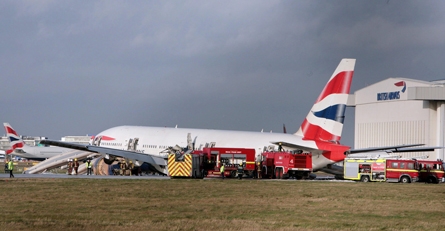UK investigators remain unable to explain the reduction in fuel flow that led to a British Airways Boeing 777-200ER losing power in both engines and landing short of the runway at London Heathrow in January.
The Air Accidents Investigation Branch has issued an update to the inquiry into the 17 January accident. Flight recorder information shows that the Rolls-Royce Trent 800s' engine control system detected the reduced flow and commanded fuel-metering valves to open fully. While the valve responded to this command, says the AAIB, there was "no appreciable change" in the fuel flow to either engine.
"Evidence to date indicates that both engines had low fuel pressure at the inlet to the high-pressure pump," it says. "Restriction in the fuel system between the aircraft fuel tanks and each of the engine high-pressure pumps, resulting in reduced fuel flows, is suspected."
 |
|---|
Detailed examination of the fuel system and pipes, the AAIB points out, has found no unusual deterioration or physical blockage.
Boeing is concentrating on attempting to replicate cruise-altitude environmental conditions experienced by the Beijing-London flight at it passed over Siberia, to test a representation of the twinjet's fuel system.
The aircraft passed through a region of particularly cold air between the Russian Ural mountains and eastern Scandinavia, although the fuel temperature did not fall below -34°C (-29°F). The fuel on board had a measured freezing point of -57°C.
"These tests are collectively aimed at understanding and, if possible, replicating the fuel system performance experienced on the day and the potential for formation of restrictions," says the AAIB, which adds that work has begun "on developing a more complete understanding of the dynamics of the fuel as it flows from the fuel tank to the engine".
There is no evidence, it says, of core engine icing or any anomalous behaviour in the aircraft or engine systems that might indicate electromagnetic interference. Investigators have also ruled out fuel contamination, a wake vortex encounter and bird strike.
Neither Boeing, nor Rolls-Royce, nor the investigation team has put forward any recommendations for operational changes.
Source: Flight International
















